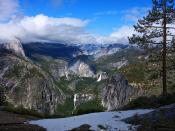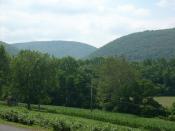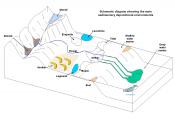Nippenose Valley Observations
The summit of north White Deer Ridge on route forty four allows for a view of the Nippenose valley below. From this elevation one is able to get a clear look at the sandstone that marks the ridge, as well as the limestone of the valley itself. Of the two rocks, it is probable that the sandstone would be more resistant to weathering, due to its elevation in the ridge and composition. The primary benefit of this stop is that it allows an overview. From this perspective one can identify that the valley runs east to west, with the beds dipping north to south. This fold in the structure is classified as anticline, with the oldest rocks forming in the valley. This is because the dip away from the axis. The direction of compression that created this fold seems to be from east to west.
The three depositional settings in the abandoned quarry area in the Nippenose valley are examples of resulting formations of conditions that, although clearly different, are interconnected.
The first group of what is referred to as the Middle Ordovician Snyder Formation is located in the lowermost strata of the quarry. Marked cosmetically by its strongly weathered appearance and largely dark grey color, can be immediately identified as a carbonate by its lack of reaction to acid. This lime-mud's bed geometry is planer, with a thickness varying from roughly one to six feet. Interestingly, fossils are easily identifiable within this group. This and the other observed conditions of the vicinity lead to the conclusion that the lowermost strata were probably subject long ago to deep subtidal, or open marine conditions. It is clear from the weathering patterns apparent in the rocks that it was below the wave base. Group two, which refers to the...


